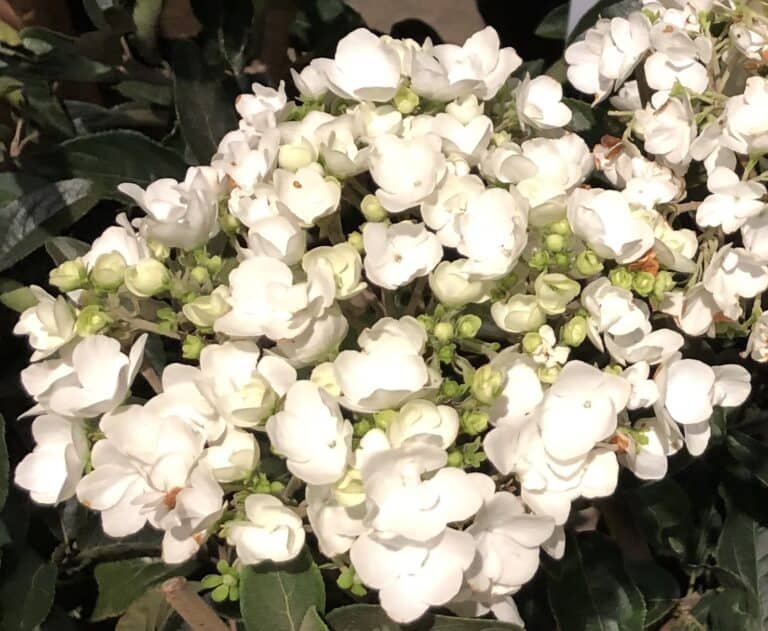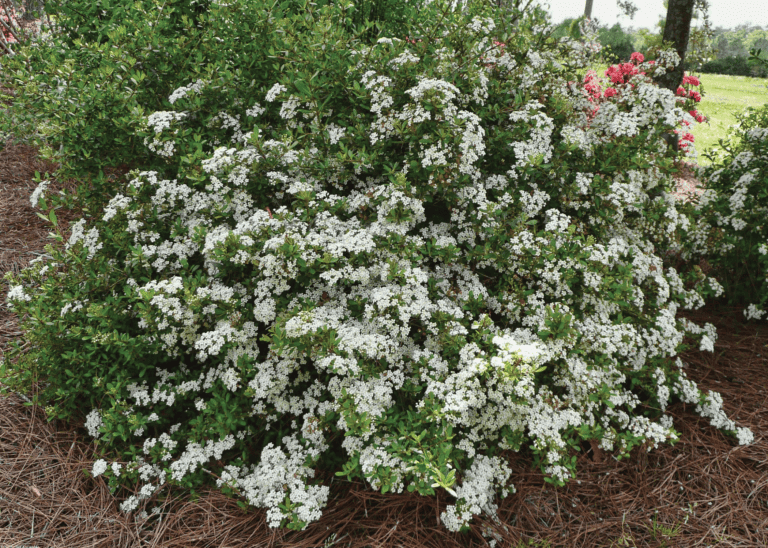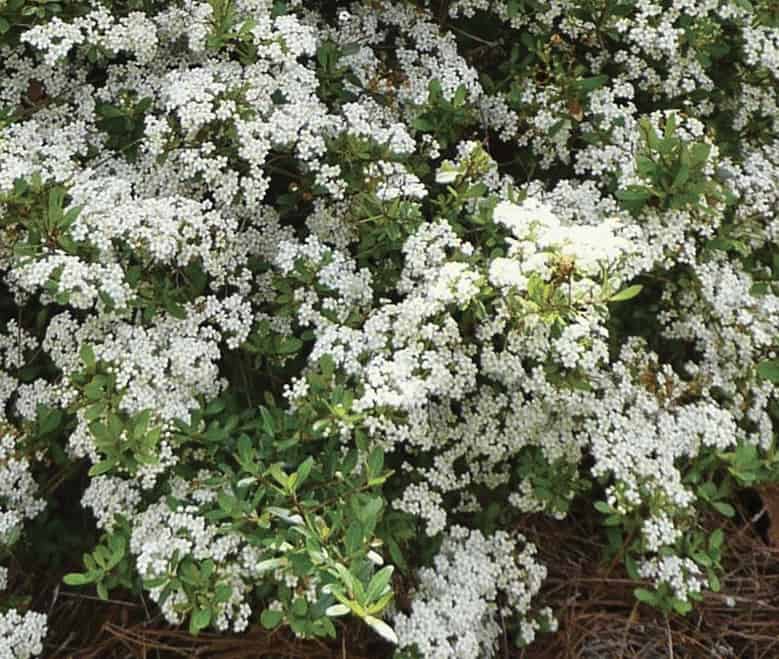Viburnum, an evergreen shrub with fine textured foliage and fragrant flowers, makes an excellent foundation planting.
Viburnum is an underutilized shrub or small tree. Evidence of being found since
the Bronze Age, Viburnums consist of clusters of white or pink flowers and
produce berries. The flowers reportedly represent pride. Most are said to be non-
toxic to humans or animals. The berries of the V. lentago or Nannyberry are
reported to be edible and can be eaten raw or made for jam. They say Native
Americans and early settles ate them as they taste like a cross between a banana
and a prune. (I am not recommending you eat these!)
Viburnum is a large, diverse group of shrubs or small trees. They were previously
in the honeysuckle family, Caprifoliaceae. The 105-175 species now belong to the
moschatel family or Adoxacea. Viburnum have generally oval, handsome leaves
and clusters of typically white and sometimes fragrant flowers that attract
butterflies. Blossoms are usually followed by single-seeded, brilliantly colored
fruit that will bring birds to your landscape. Viburnums are grown for their flower
display and a few for their showy fruit. Heaviest fruit set occurs when several
different named selections of seedlings that bloom at the same time are planted
together. Many evergreen types are valuable as foliage plants.
Thrips could be an issue, treat with appropriate insecticide if needed but
Viburnums are not usually seriously bothered by pests or diseases and aren’t
bothered by deer.

‘Viburnum macrocephalum’
Chinese Snowball Viburnum
Viburnums have a wide range of climate adaptability. The prefer sun, partial shade
to even shade depending on the variety. Plant viburnum in slightly acidic soil.
Many types will do well in alkaline soil. Always read the plant label to learn about
the variety you want to grow. Most viburnums prefer moist soil that drains
well. Put your viburnum on a regular watering schedule if they aren’t receiving
enough through regular rainfall totals. Once established, native varieties will be
relatively drought tolerant. Viburnums are a large and diverse group of plants, but
most prefer moderate temperatures and humidity. Protect viburnum through
extreme heat with extra watering and through extreme cold to prevent dieback.
Add a time-release fertilizer to the soil every spring, following the directions on
the product label, until the plant is established. Viburnum blooms on old wood, so
prune the plant after it has bloomed. If you prune before it blooms, you’ll miss the
show. Remove leggy shoots and damaged branches. Some varieties of viburnum
have a tree form and might require pruning to maintain its shape.

‘Mrs. Schiller’s Delight’
V, obovatum
Viburnum can be propagated from new soft wood or hard wood cuttings. For soft
cuttings, cut a 4-to-6-inch branch and remove leaves from the lower third of the
wood. For hard cuttings, cut a 10-inch branch and remove leaves from the lower
half. Dip the stem in rooting hormone. Plant the cutting in a container or pot with a mixture of peat and perlite. Cover the cutting with plastic to keep the soil moist
and set the pot in indirect light. Soft wood will root in a few weeks. Hard wood
will root in a few months. Once rooted, remove the cover and put the pot in bright, indirect light. Acclimate cuttings to the outdoors by putting it in a protected area for a few hours each day to help it transition to the elements. After about 10-14 days, plant it in the garden.
‘Mrs. Schiller’s Delight’ viburnum. Is a recommendation from the LSU Super
Plant selection for 2016. A native shrub, Mrs. Schiller’s Delight, Viburnum
obovatum or Walter’s Dwarf Viburnum, can be a substitute for Indian hawthorn,
dwarf yaupon, dwarf hollies and similar popular evergreen foundation shrubs.
Maintainable at 3 feet to 4 feet tall and grows to a height of 5 feet. Space plants 4
feet to 5 feet apart in full sun, part sun or part shade in a well-prepared landscape bed. Small clusters of white flowers cover the canopy in midspring for four weeks.
Makes a nice addition to woodland, filtered-shade native gardens. Known for its landscape toughness. Prune if needed in spring after flowering is completed.
Irrigation is needed during periods when rainfall is absent for two to three weeks
according to Dr. Allen Owings, retired, Research Horticulturist LSU AgCenter.

‘Mrs. Schiller’s Delight’
V, obovatum
Other Viburnums you may want to consider:
V. dentatum. Arrowwood, named reportedly as Native Americans used it for arrow
shafts. Deciduous. Zones 6-9. 6–10 ft. or taller, equally wide. Open density.
Cream-colored flowers in late spring are followed by blue-black fruit. Dark green,
oval to rounded, 4-inch leaves turn yellow, orange, or deep red in fall. Plants
tolerate heat, cold, and alkaline soil. Use as a screen or tall hedge. ‘Cardinal’ has a
dark red fall color. ‘Blue Muffin’ is a low, compact selection reaching only 5–7 ft.
high and 4 ft. wide with blue fruit in Fall.
V. japonicum. Japanese Viburnum is evergreen. Zones 8-10. From Japan. Grows
fast, 10–15 ft. tall, 8–12 ft. wide; can be trained as a small tree. Leathery, glossy,
dark green leaves to 6 in. long. Sparse spring show of fragrant flowers in 4-in.
clusters. Red fruit is likewise sparse but very attractive. Best with some shade.
V. luzonicum. Luzon Viburnum is evergreen & deciduous in cooler zones. Zones
7-9. Native to Taiwan and the Philippines, large shrub or small tree. In the Lower
South the evergreen foliage is yellow green in Spring, turns red and persists for fall
color. Grows to 20 ft. tall and 15 ft. wide. Flat clusters of white flowers are
followed by sparse red fruits.
V. macrocephalum. ‘Chinese Snowball’. Deciduous in colder areas, it is nearly
evergreen for us. Zones 6-9. Rounded habit to 12–20 ft. tall and wide. Dull green,
oval to oblong, 2 to 4-in leaves. Big, rounded, 6- to 8-in. flower clusters bloom in
spring (or any time during warm weather); they are composed of sterile flowers
that start out lime-green, change to white. No fruit. Can be espaliered.
V. nudum ‘Winterthur’. Deciduous viburnum, Zones 6-9. Native to Southern
states, this shrub grows 6–10 ft. tall and wide. The sheen on the dark green leaves
gives the fall foliage more impact as it turns red. The flat-topped, creamy white
flower clusters in early summer are followed by fruit that progresses through pinks
and reds on its journey from green to black. Tolerates occasionally wet soil but
grows in average garden soil as well. Propagated by seeds.
V. odoratissium awabuki. Awabuki viburnum is evergreen. Zones 7-9. Native to
Taiwan and Japan, fast growing to 12 ft. tall with upright form. Foliage is glossy
and dark green. Mildly fragrant, early-summer white flower cluster followed by
red fruit that turns black. ‘Chindo’ has large, red, pendant fruit clusters.

By Karen Blackburn
Master Gardener of Greater New Orleans
Photo credits:
Karen Blackburn
Dr. Allen Owings

